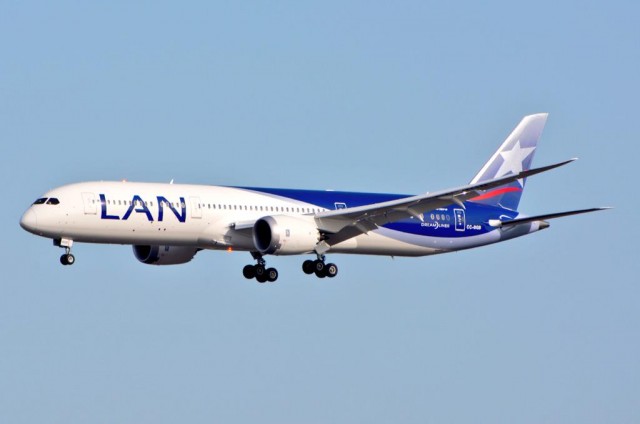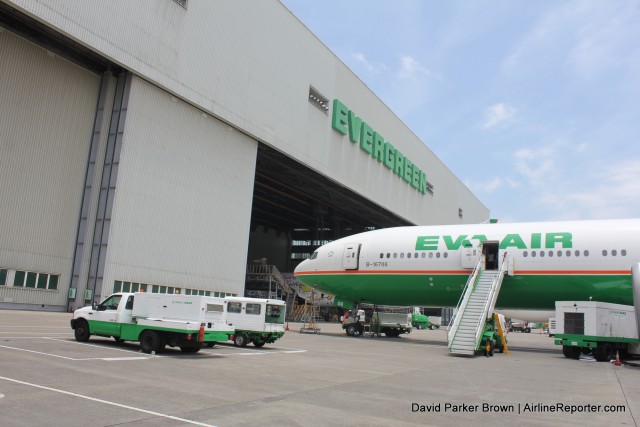
An EVA Air Boeing 777-300ER being worked on
During my recent trip to Taipei, I was invited to check out the Evergreen Aviation Technologies (EGAT) maintenance facility, but before I could check things out, I first had to get there.
You know how they say, “getting there is half the fun?” Well, in this case… it was. My hotel was located about 45 minutes from the airport, and I was told that I would have a car sent to pick me up — cool. I was greeted in the lobby and headed outside, but where was my car? I was told that we needed to walk down the block a bit, since they couldn’t find parking. That was odd, as there was plenty of parking right in front of the hotel, but okay.
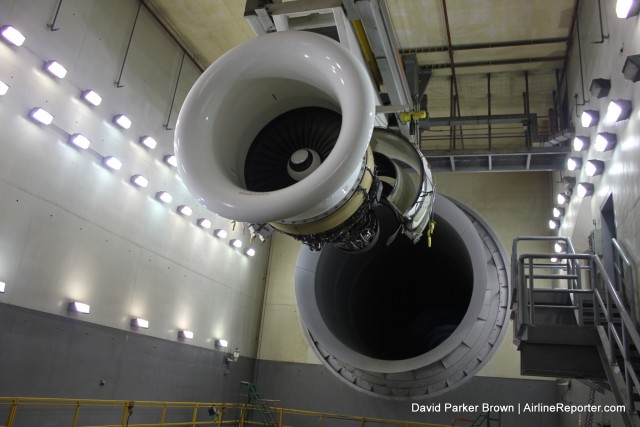
Engine testing at EGAT in Taipei
Then I stopped to take some photos of a big tourist bus that had EVA Air’s livery on it. I felt it odd that the guy was going up to the bus. Wait a second… was this my ride? Sure was… my ride was a super sweet EVA-liveried bus all for me (and the driver… and my guide). I guess they had run out of vans and cars and didn’t want me to be left waiting, so they sent a bus. I was totally okay with that.
This was one of many things that showed how much that EGAT takes pride in attention to detail. A high level of precision is important when giving someone a tour, but way more important when working on an airline’s multi-million dollar aircraft.
The Blue Angels are known for their high precision, mesmerizing aerobatic shows. What is it like to be around and fly with such an elite group for a day? Simply put: inspiring. Maybe it’s their outstanding skill, balanced with admirable humbleness which is so inspiring, or their thorough understanding of every maneuver that must be made – or perhaps it’s just their snazzy uniforms. Either way, here is your inside look into riding with the Blue Angels.
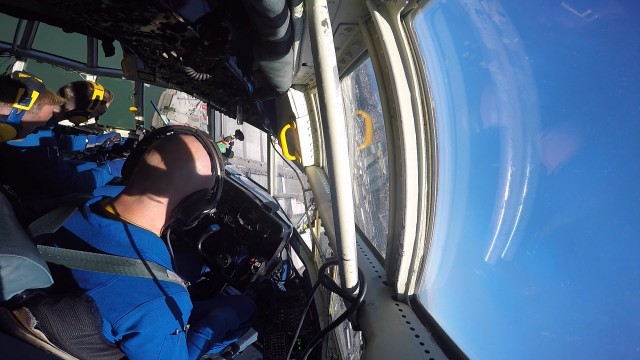
Low, steep bank in residential area – Photo: Kassy Coan | AirlineReporter
The demonstration flight on the C-130, known as “Fat Albert,” while not on one of the F/A-18 fighter jets, it is still a thrilling flight made of both positive and negative G-forces. I was lucky enough to be invited to a demonstration flight over Seattle this past Friday, during the SeaFair show. The experience forces up to 2G, causing me to feel up to double my weight. The negative-G experience, also known as weightlessness, was (according to the cheers on-board) the best part.
Preparing for flight, we had a briefing of what to expect. On at least three different occasions, I was asked if I get motion sickness and told how to puke in a low-G environment. Pro tip: remember to close the barf bag!
It was exciting, but also intimidating to hear the speed and confidence with which each maneuver was explained. The intensity and timing of every turn, ascent and descent, is planned in advance. While I’ve never gotten motion sickness before, and I’ve always been a roller-coaster junkie, even I was beginning to second-guess myself.
I think the most common question people have about flying premium cabins on overnight flights is “can I sleep?” When recently flying from New York’s JFK to Santiago, Chile (SCL), in LAN’s business class on the 787-9 Dreamliner, I was hoping to check out the amenities, but I was also looking to sleep. This was to be my first 787-9 flight and it was CC-BGC, which was delivered to LAN on June 25, 2015, just 25 days before my flight.
Maybe it’s just me, but I generally find that for a true overnight flight, under twelve hours, I am concerned about exactly one thing: is the seat flat? Do I care about the service? Sure, but I rarely get a chance to partake, as I am typically asleep until 90 minutes before landing to get ready for the new day and eat breakfast.
This makes reviewing hard. I want to say so many amazing things about LAN because they are fantastic, but short overnight flights always make me feel like I missed out on something.
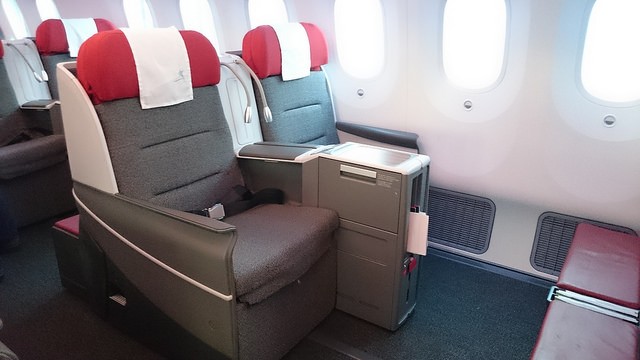
LATAM’s harmonized business class product was designed by Priestmangoode and features a 2-2-2 layout – Photo: Jason Rabinowitz
LAN is a tenant of Terminal 8 at JFK (American Airlines’ home) – because of this, the only premium lounges in Terminal 8 (save the Flagship First room) are regular Admiral’s Clubs. While LAN Premium Business customers are entitled to a free alcoholic beverage, that says nothing of the food.
In LAN’s beautiful Santiago lounge, this would not be a problem. In the Terminal 8 Admiral’s Club, the only food on offer are tiny cups of soup, some oddly rubbery cookies, and suspicious looking cheese. Could a LAN flyer purchase something more substantial? Yes, but the thing is, I have had too many of the $11 Admiral’s Club paninis. They are, to put it gently, not what you would expect from food in a seemingly premium environment.
But, when I was able to board my 787-9, things were completely different.
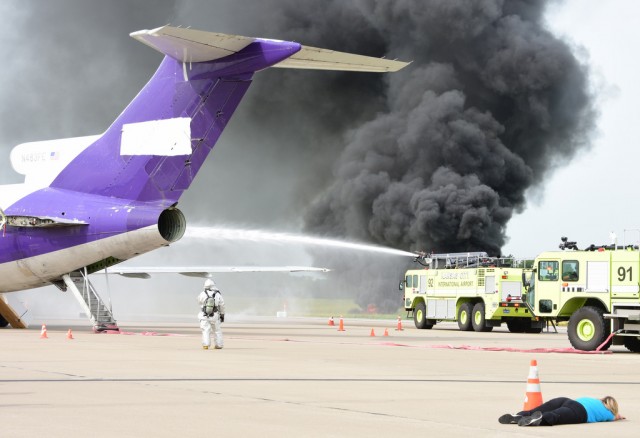
Full-scale disaster drill at Kansas City International, in full swing – Photo: JL Johnson | AirlineReporter
Practice makes perfect. And in the realm of aviation safety drills, it also creates incredible experiences for willing volunteers. Kansas City International Airport (MCI, or KCI as it’s referred to by the locals) recently hosted their triennial emergency exercise, and I was fortunate enough to score a role as a victim. I was told this was a full-scale drill from the beginning, but wasn’t sure exactly what to expect.
The closest I’ve ever been to anything remotely resembling an emergency was on my very first Airbus A320 flight just a few years ago from Minneapolis (MSP) to Pittsburgh (PIT). It was late, and after a typical approach the engines roared and we were on steep climb. Upon leveling off, the Delta captain came on to tell us we had briefly “lost steering.” After a missed approach and a fly-by, we landed uneventfully, were greeted by an ARFF (aircraft rescue and firefighting) escort, and towed to the gate. This experience, plus participating in some rudimentary safety training with Delta during last year’s #InsideDelta event, formed the foundation for my expectations.
I would soon learn I had no idea how disasters really play out, especially on the ground’¦
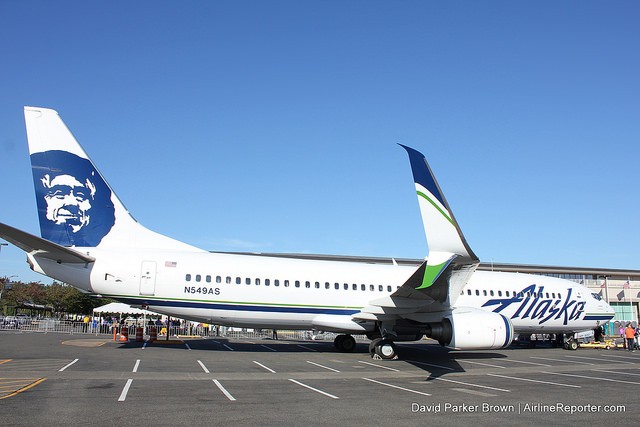
The 737-800, ready to be pulled
Earlier this week, I was invited by Alaska Airlines to watch the Alaska Plane Pull for Strong Against Cancer at the Museum of Flight in Seattle. The two competing teams were led by Russell Wilson, quarterback of the Seattle Seahawks and Alaska’s ’œChief Football Officer,’ and actor and comedian Joel McHale, who grew up on Mercer Island (right outside of Seattle) and is known for his role in the series ’œCommunity’ and as host of E!’s ’œThe Soup.”
Each celebrity captain had 18 team members, comprised of employees from Alaska’s maintenance and engineering departments, as well as members of the community who were the lucky winners of Alaska’s Facebook contest.
Who could pull a 92,000-pound 737-800 25 feet in the least amount of time? I was there to find out!




